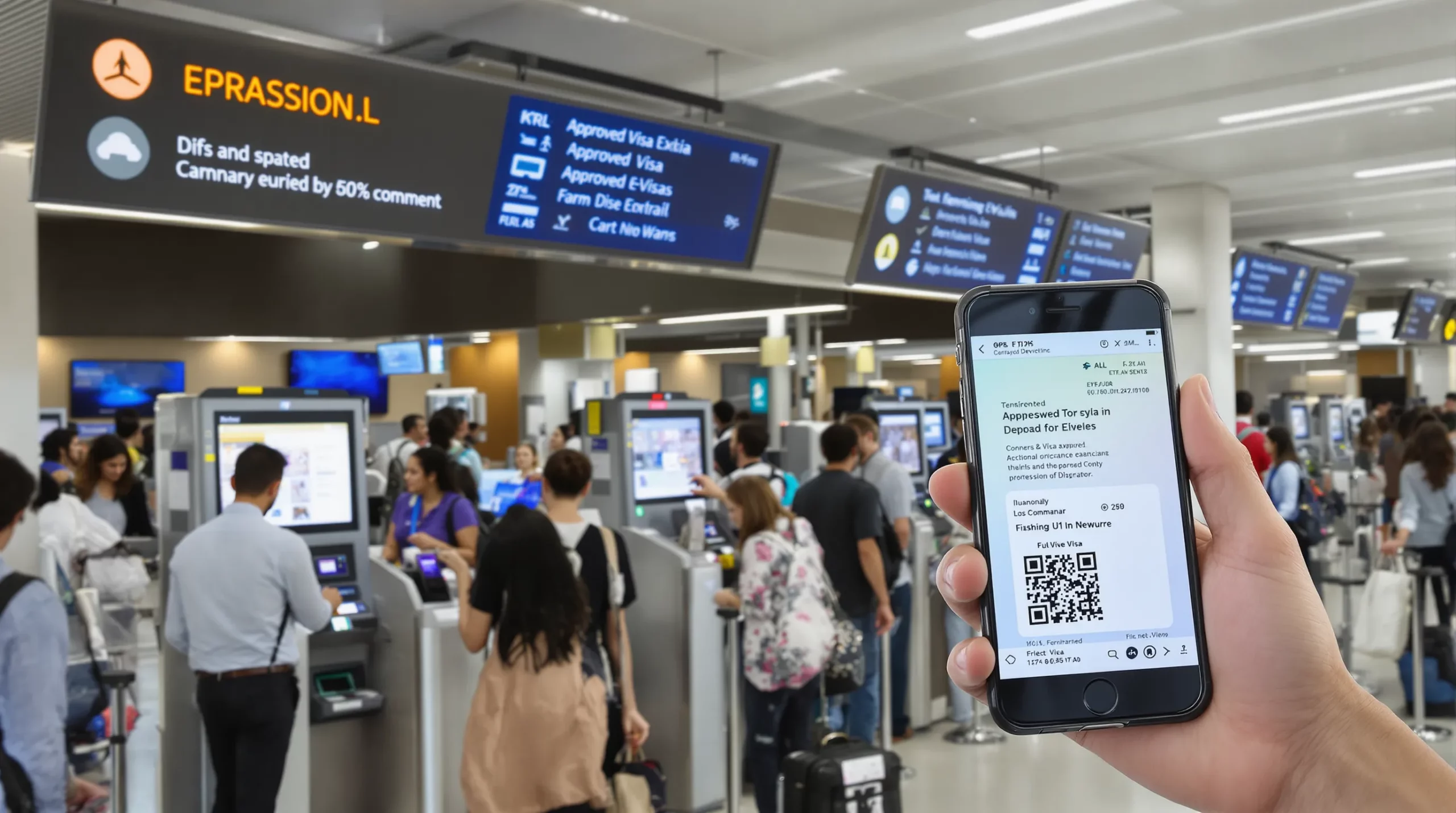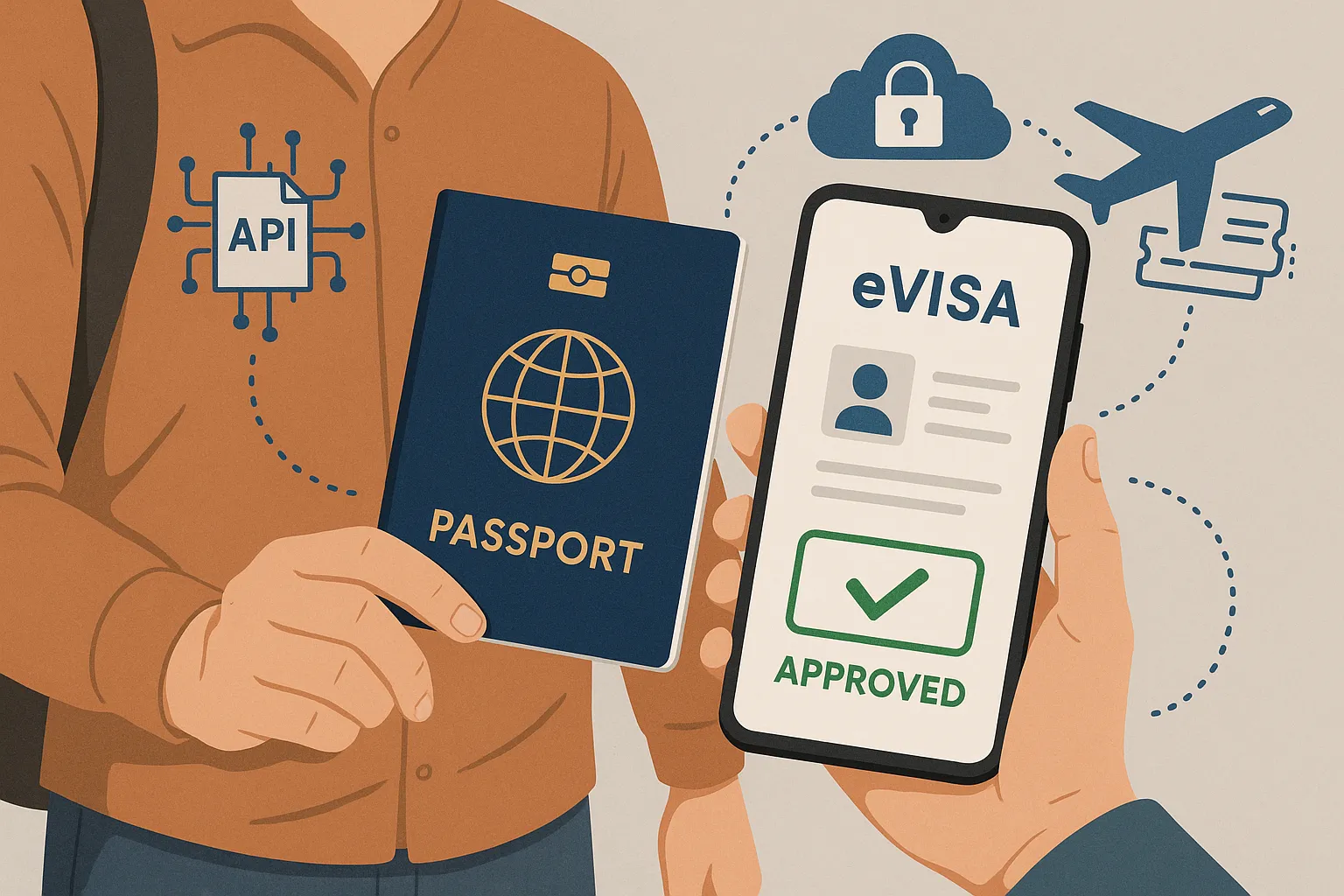The Complete Glossary of Electronic Visa Terminology

Why publish an electronic-visa glossary in 2025?
Borders have reopened, digital travel credentials are rolling out, and more than 60 governments now issue some form of eVisa, according to the International Air Transport Association (IATA). Yet newcomers to the topic quickly get lost in an alphabet soup of acronyms (ETIAS, ETA, SEI) and technical jargon (MRZ, OCR, REST API). This glossary gathers the expressions you are most likely to meet when discussing electronic visas so that travel brands, developers, and frequent flyers can speak the same language.
Use it as a quick reference or read it end-to-end for a crash course on modern visa management. Where relevant, you will find links to deeper articles on SimpleVisa or to credible industry sources.
A
API (Application Programming Interface) A set of rules that lets two software applications communicate. SimpleVisa’s travel API enables agencies and airlines to submit visa data directly from the booking flow, creating an ancillary-revenue opportunity while staying in their own UX.
Application ID The unique reference number assigned by the issuing authority to track an individual eVisa request.
Arrival Card A short form some countries still ask visitors to fill out on landing. When eVisa systems are fully integrated, arrival-card data can be pre-populated from the electronic application.
B
Biometric Verification The use of fingerprints, facial recognition, or iris scans to confirm an applicant’s identity. ICAO Doc 9303 sets the global standards for biometric passports that most eVisa systems rely on.
Border Crossing Solution A tech stack (software, hardware, data) that automates the compliance checks required when a traveler enters or exits a country. SimpleVisa provides border crossing solutions that focus on the visa dimension, leaving hardware to airport partners.
C
Consular Fee The amount charged by a government to process a visa request. Consular fees often differ from the Service Fee retained by a commercial visa platform.
CSV Upload A bulk-application feature that lets travel operators import dozens of travelers at once by uploading a comma-separated values file.
D
DS-160 The online form used by the United States for most non-immigrant visas. Although strictly speaking it is not an eVisa (a passport sticker is still issued), many travelers encounter the DS-160 when researching “online visa application”.
Digital Travel Credential (DTC) An ICAO-defined digital copy of the passport data page. Pilot projects in Finland and the Netherlands are testing DTCs that could eventually replace physical passports at automated gates.
E
eGate An automated border checkpoint that verifies a traveler’s identity and permissions— including an eVisa — without human intervention.
Electronic Travel Authorization (ETA) A lightweight pre-screening required by countries such as Australia or Canada. ETAs differ from eVisas in that they usually apply to visa-exempt nationalities and come with fewer data requirements.
ETIAS (European Travel Information Authorization System) The upcoming pre-travel authorization for visa-exempt visitors to the Schengen Area. Read our practical overview of the ETIAS application process.
eVisa A travel authorization delivered and stored electronically, eliminating the need for physical stickers or stamps. See the full list of advantages in our article on the benefits of electronic visas.
F
Front-End Widget A plug-and-play user-interface component that travel websites can embed to collect passenger data for visa processing. SimpleVisa offers a no-code widget that can be activated in less than an hour.
Full-Service Provider A company managing every step of the visa lifecycle (eligibility check, payment, government liaison, traveler support) under its own or a white-label brand.
G
Government Gateway The official portal through which visa applications are submitted. Commercial platforms typically integrate with a gateway via SOAP, REST, or SFTP.
Global Distribution System (GDS) A network (Amadeus, Sabre, Travelport) that distributes flight, hotel, and ancillary content to travel sellers. Some providers are working on surfacing visa offers as an ancillary product in the GDS.
H
Host-to-Host Integration A direct, server-to-server data exchange between two organizations. Government agencies often require host-to-host connectivity to receive high-volume visa feeds from airlines.
I
IATA Timatic The database airlines use to verify passenger travel document requirements. Timatic now includes real-time eVisa and ETA information, which SimpleVisa supplements with country-specific form logic.
In-App Upsell The practice of offering visa services inside a mobile booking app. Done properly, it raises conversion and generates incremental revenue.
J
JSON (JavaScript Object Notation) A lightweight data-interchange format widely used to transmit visa application payloads through modern APIs.
K
KYC (Know Your Customer) Compliance process that verifies user identity and screens against sanctions lists. KYC checks are increasingly embedded into eVisa flows to fight fraud.
L
Landing Permission The authorization (visa, ETA, or exemption) required to be admitted upon arrival. Airlines risk fines, known as carrier sanctions, if they transport passengers lacking the proper landing permission.
M
Machine Readable Zone (MRZ) The two or three lines of OCR-friendly characters at the bottom of a passport data page. eVisa systems parse the MRZ to extract key biographic details quickly and accurately.
Multilingual Support The ability of a visa platform to display form fields, help text, and notifications in multiple languages. Multilingual capability is critical for airlines selling tickets worldwide.
N
No-Code Implementation A deployment method that lets non-technical staff integrate visa functionality through configuration (embedded script, CMS plugin) instead of custom code.
Nationality Filter Logic that masks or modifies a visa offer based on the user’s passport. For example, Japanese nationals see an ETA, while Indian nationals see a full eVisa form.
O
OCR (Optical Character Recognition) Technology that converts images of passports or IDs into machine-readable text. When paired with liveness detection, OCR speeds up form filling and reduces errors.
P
Passport Power An index measuring how many destinations a passport grants visa-free or eVisa access to, popularized by the Henley Passport Index. Explore the economic impact in our article on passport power and visa-free travel.
Payment Gateway The service that processes application fees. A robust gateway must accept multiple currencies and handle 3-D Secure to meet PSD2 requirements in Europe.
Q
QR Code Visa A visa rendered as a QR code that officials scan on arrival. The code is usually linked to a backend database for real-time status validation.
R
REST API The de-facto standard for web APIs using HTTP methods (GET, POST, PUT, DELETE). SimpleVisa exposes REST endpoints to check eligibility, create applications, and retrieve status.
Return-to-Agency Alert A notification informing a travel advisor that a client’s application needs additional documents or clarifications.
S
SEI (Single Electronic Interface) A concept promoted by the European Commission to harmonize how carriers transmit passenger data, including visa details, to Schengen states. SEI aims to replace the patchwork of local systems airlines face today.
Status Webhook A server callback that pushes real-time updates (approved, pending, rejected) to the partner system as soon as the government gateway responds.
STP (Straight-Through Processing) An end-to-end automated workflow requiring no manual intervention from data capture to visa issuance.
T
Timatic Auto-Populate A feature that fills visa forms with data retrieved from IATA Timatic, accelerating submission time.
Two-Factor Authentication (2FA) An added security layer often required to access the back-office of visa management platforms.
U
UX (User Experience) The overall feel of the visa application journey. Clear instructions and real-time validation remain decisive factors in high approval rates, as highlighted in our post on successful visa processing.
V
Visa On Arrival (VoA) Authorization granted at the border rather than online or at an embassy. Travelers still appreciate VoA as a fallback but prefer eVisas due to predictable approval before departure.
Visa Waiver Program (VWP) A policy allowing nationals of certain countries to travel without a traditional visa. The U.S. VWP requires an ESTA, an electronic travel authorization akin to an ETA.
W
White-Label Solution A product offered under a partner’s own brand. SimpleVisa’s white-label visa app lets OTAs and TMCs retain customer ownership while leveraging our processing engine.
Webhook See Status Webhook above — frequently used in white-label deployments.
X
XML Feed A structured data file sometimes still used by legacy border systems. Although JSON has become dominant, XML remains common in government integrations.
Y
Yield Management The practice of adjusting inventory or price to maximize revenue. Forward-thinking airlines apply yield management principles to ancillaries such as visa services.
Z
Zero-Knowledge Encryption A security model in which the service provider cannot access the decrypted data it stores. Some governments require zero-knowledge protocols for sensitive biometric information.
Quick reference table of the top 15 acronyms
| Acronym | Full Meaning | Typical Use Case |
|---|---|---|
| API | Application Programming Interface | Connect booking engine to visa platform |
| ETA | Electronic Travel Authorization | Pre-screening for visa-exempt travelers |
| eVisa | Electronic Visa | Digital alternative to embassy-issued visa |
| ETIAS | European Travel Information Authorization System | Mandatory for Schengen arrivals starting 2025-26 |
| GDS | Global Distribution System | Distribute visa ancillaries to travel agents |
| IATA | International Air Transport Association | Maintains Timatic requirements database |
| ICAO | International Civil Aviation Organization | Sets passport and biometric standards |
| JSON | JavaScript Object Notation | Data format for API payloads |
| KYC | Know Your Customer | Fraud prevention in visa issuance |
| MRZ | Machine Readable Zone | Rapid extraction of passport data |
| OCR | Optical Character Recognition | Auto-populate application forms |
| REST | Representational State Transfer | Architecture for web APIs |
| SEI | Single Electronic Interface | Harmonized data push to EU states |
| VoA | Visa On Arrival | Backup option when eVisa unavailable |
| VWP | Visa Waiver Program | 90-day travel to USA with ESTA |
How SimpleVisa can help
Navigating the terminology is only the first step. Turning knowledge into a seamless traveler experience demands technology that keeps pace with changing regulations. Whether you need a low-code widget, a full REST API, or a white-label visa marketplace, SimpleVisa offers a range of options that fit your development resources and commercial strategy.
- Embed our eligibility widget in less than 30 minutes to capture incremental revenue per passenger.
- Use our eVisa APIs to pre-populate applications, collect payments, and fetch real-time status updates.
- Leverage premium data services to power personalized messages, e.g., remind travelers when their USA ESTA is about to expire.
Book a demo to see how fast you can move from glossary to go-live.

Master these terms, and you will read policy updates with confidence, negotiate smarter with technology partners, and, most importantly, offer your customers the frictionless journeys they expect in 2025.